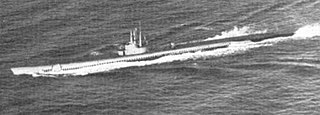
USS Runner (SS/AGSS-476), a Tench-class submarine, was the second ship of the United States Navy to be named for the runner, an amberfish inhabiting subtropical waters.

USS Cavalla (SS/SSK/AGSS-244), a Gato-class submarine, is a submarine of the United States Navy named for a salt water fish, best known for sinking the Japanese aircraft carrier Shōkaku.

USS Pipefish (SS-388/AGSS-388), a Balao-class submarine, was the only ship of the United States Navy to be named for the pipefish.
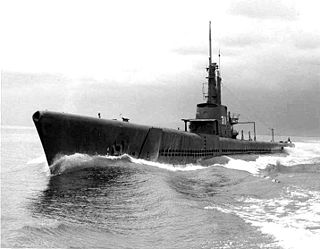
USS Archerfish (SS/AGSS-311) was a Balao-class submarine. She was the first ship of the United States Navy to be named for the archerfish. Archerfish is best known for sinking the Japanese aircraft carrier Shinano in November 1944, the largest warship ever sunk by a submarine. For this achievement, she received a Presidential Unit Citation after World War II.

USS Bashaw (SS/SSK/AGSS-241), a Gato-class submarine, was the first ship of the United States Navy to be named for the bashaw. Between 10 March 1944 and 29 April 1945, she completed six war patrols in the Celebes, Philippine, and South China Seas during World War II. Bashaw sank three Japanese merchant vessels totaling 19,269 gross register tons as well as several small craft. She later served in the Vietnam War.

USS Croaker (SS/SSK/AGSS/IXSS-246), a Gato-class submarine, was the first ship of the United States Navy to be named for the croaker, any of various fishes which make throbbing or drumming noises.

USS Redfin (SS/SSR/AGSS-272), a Gato-class submarine, was a ship of the United States Navy named for the redfin, any of several North American fishes with reddish fins.

USS Rock (SS/SSR/AGSS-274), a Gato-class submarine, was a ship of the United States Navy to be named for the rockfish, a striped bass found in the Chesapeake Bay region and elsewhere along the United States East Coast.
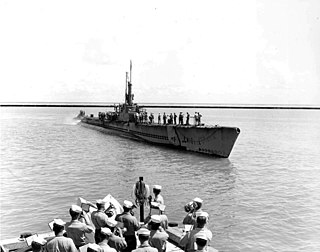
USS Cabrilla (SS/AGSS-288), a Balao-class submarine, was a ship of the United States Navy named for the cabrilla, an edible fish inhabiting the Mediterranean Sea and waters off the coast of California.

USS Devilfish (SS/AGSS-292), a Balao-class submarine, was a ship of the United States Navy named for the devil fish.

USS Manta (SS/ESS/AGSS-299), a Balao-class submarine, was the first submarine and second ship of the United States Navy to be named for the manta.
USS Moray (SS-300), a Balao-class submarine, was a ship of the United States Navy named for the moray, a family of large eels found in crevices of coral reefs in tropical and subtropical oceans.

USS Becuna (SS/AGSS-319), a Balao-class submarine in commission from 1944 to 1969, was ship of the United States Navy named for the becuna, a pike-like fish of Europe. During World War II, she conducted five war patrols between August 23, 1944 and July 27, 1945, operating in the Philippine Islands, South China Sea, and Java Sea. She is credited with sinking two Japanese tankers totaling 3,888 gross register tons.

USS Caiman (SS-323), a Balao-class submarine, was a ship of the United States Navy that was later transferred to the Turkish Naval Forces in 1972 under the Security Assistance Program, where she was recommissioned as the third TCG Dumlupınar. She was retired in 1986.
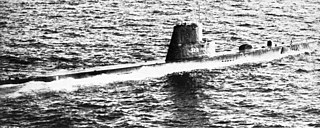
USS Charr (SS/AGSS-328), a Balao-class submarine, was a ship of the United States Navy named for the charr.

USS Sea Poacher (SS/AGSS-406), a Balao-class submarine, was a vessel of the United States Navy named for the sea poacher, a slender, mailed fish of the North Atlantic.

USS Icefish (SS-367), a Balao-class submarine, was a ship of the United States Navy named for the icefish, any member of the family Salangidae, small smeltlike fishes of China and Japan. These fish are also collectively known as whitebait.

USS Loggerhead (SS-374/AGSS-374), a Balao-class submarine, was a ship of the United States Navy named for the loggerhead, Caretta caretta, a very large, carnivorous sea turtle common in the warmer parts of the Atlantic, Pacific, and Indian Oceans.

USS Sea Cat (SS/AGSS-399), a Balao-class submarine, was a ship of the United States Navy named for a shortened form of sea catfish, a marine fish of little food value found off the southeastern coast of the United States commissioned on 16 May 1944, with Commander Rob Roy McGregor in command. During World War II Sea Cat operated within the Pacific theatre, conducting four war patrols in wolf packs accounting for up to 17400 tons in the form of three cargo ships and an enemy vessel. Sea Cat earned three battle stars for her World War II service.
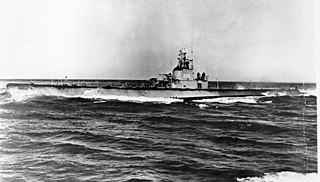
USS Cobia (SS/AGSS-245) is a Gato-class submarine, formerly of the United States Navy, named for the cobia.



















